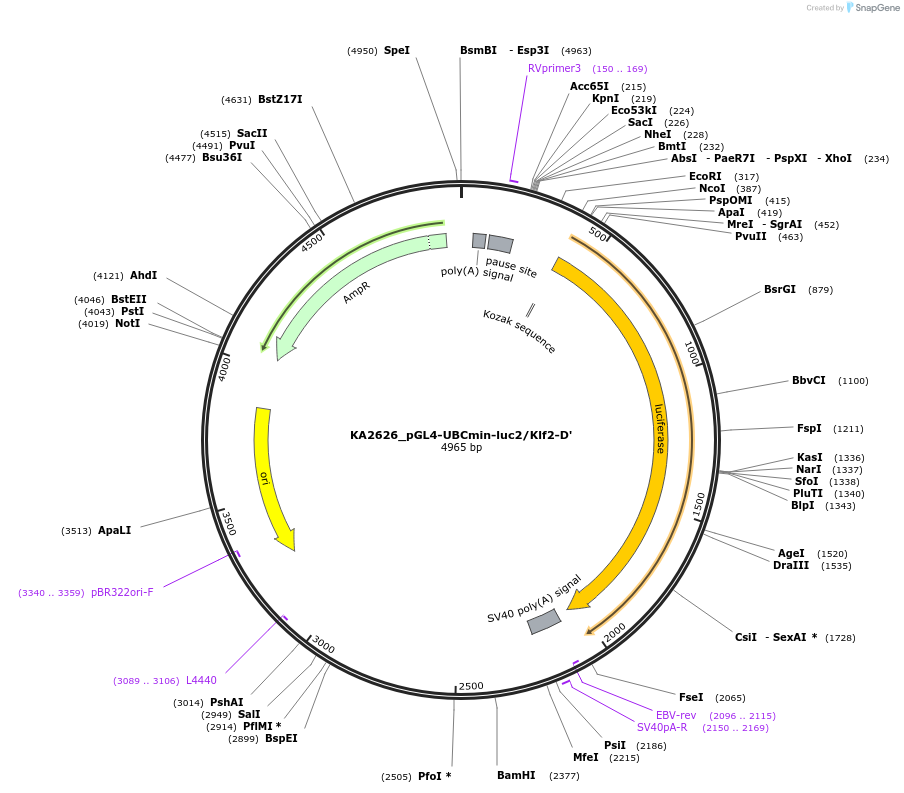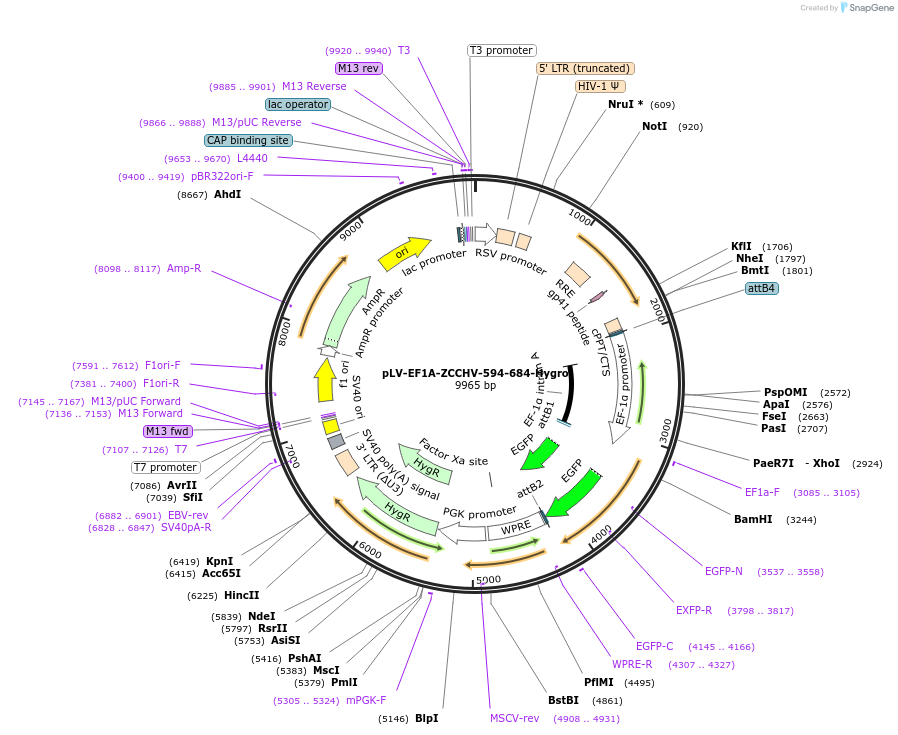We narrowed to 29,791 results for: REP
-
Plasmid#164412PurposeTransient Reporter for Editing Enrichment (TREE) Plasmid. GFP turns on with adenosine base editing (ABE). 2 stop codons.DepositorInsertmCherry
UseCRISPR and Synthetic BiologyTagsT2A-GFPExpressionMammalianMutationPromoterEF1-alphaAvailable SinceAug. 3, 2021AvailabilityAcademic Institutions and Nonprofits only -
pRS415-Cas9-VPR
Plasmid#163971PurposeTrifunctional Cas9-VPR fusion protein plasmid for simultaneous transcriptional activation, transcriptional repression, and genome editing in yeastDepositorInsertCas9-VPR
UseSynthetic BiologyTagsExpressionYeastMutationPromoterAvailable SinceFeb. 2, 2021AvailabilityAcademic Institutions and Nonprofits only -
pOCC193
Plasmid#118903Purposeshuttle vector for baculovirus production, using FlashBac bacmid; for recombinant protein with N-terminal MBP, cleavable with 3C and monomeric GFP and C-terminal TwinStrep, cleavable with 3CDepositorInsertNcoI-MBP-3C-mGFP-NotI-ccdB-AscI-3C-TwinStrep-stop-HindIII cassette
UseTagsMBP, cleavable with 3C protease; mGFP and TwinStr…ExpressionInsectMutationPromoterpolHAvailable SinceJan. 3, 2019AvailabilityAcademic Institutions and Nonprofits only -
KA1396_pGL4-UBCmin-luc2/Klf4-E'
Plasmid#124187PurposeLuciferase reporter driven by the Klf4 enhancerDepositorInsertKlf4 enhancer
UseLuciferaseTagsExpressionMutationPromoterUBCminAvailable SinceMarch 27, 2019AvailabilityAcademic Institutions and Nonprofits only -
pPA-RL-FL
Plasmid#78863PurposeDULIP Tandem Construct used for data normalizationDepositorInsertFirefly
UseExpression vectorTagsProtein A, Renilla luciferaseExpressionMammalianMutationPromoterCMVAvailable SinceJuly 1, 2016AvailabilityAcademic Institutions and Nonprofits only -
Ef1a-QCP-3xBFP
Plasmid#158206PurposeQb coat protein fused to three repeats of the blue fluorescent protein under a Efla promoter.DepositorInsertQCP under the Elfa promoter and three BFP tags
UseSynthetic BiologyTags3xBFPExpressionMammalianMutationPromoterElfaAvailable SinceMarch 11, 2021AvailabilityAcademic Institutions and Nonprofits only -
pSK260
Plasmid#129252Purposedual yTRAP, NM fusion to aTF1 reporting on [PSI+] state with mKate2 reporterDepositorInsertSup35 NM yTRAP sensor reporting on mKate2
UseTagsExpressionYeastMutationPromoterAvailable SinceOct. 8, 2019AvailabilityAcademic Institutions and Nonprofits only -
KA2626_pGL4-UBCmin-luc2/Klf2-D'
Plasmid#124199PurposeLuciferase reporter driven by the Klf2 enhancerDepositorInsertKlf2 enhancer
UseLuciferaseTagsExpressionMutationPromoterUBCminAvailable SinceApril 19, 2019AvailabilityAcademic Institutions and Nonprofits only -
KA1401_pGL4-UBCmin-luc2/Klf4-F'
Plasmid#124188PurposeLuciferase reporter driven by the Klf4 enhancerDepositorInsertKlf4 enhancer
UseLuciferaseTagsExpressionMutationPromoterUBCminAvailable SinceMarch 27, 2019AvailabilityAcademic Institutions and Nonprofits only -
KA1395_pGL4-UBCmin-luc2/Klf4-B'
Plasmid#124186PurposeLuciferase reporter driven by the Klf4 enhancerDepositorInsertKlf4 enhancer
UseLuciferaseTagsExpressionMutationPromoterUBCminAvailable SinceMarch 27, 2019AvailabilityAcademic Institutions and Nonprofits only -
pJK2067
Plasmid#171845PurposeC. elegans mex-5 promoter (germline) driven dual fluorescent reporter for boxB tethering (eGFP) with boxB negative control (mCherry)DepositorInserthis-58, eGFP, mCherry
UseTagsN-terminal Tag OLLAS, V5 and C-terminal Tag PEST…ExpressionWormMutationboxB wild type and hairpin mutantPromotermex-5 promoterAvailable SinceJuly 8, 2021AvailabilityAcademic Institutions and Nonprofits only -
SEPLuc-IRES-Antares
Plasmid#141085Purposeprecursor of the bioluminescent reporter pHluc, for detecting extracellular pH changes in tumor acidosisDepositorInsertSEPLuc-EMCV IRES-Antares
UseTagsExpressionMammalianMutationPromoterCMVAvailable SinceMay 11, 2020AvailabilityAcademic Institutions and Nonprofits only -
Mut.Blimp1pGL3 (Mutant human Blimp1 promoter in pGL3-basic)
Plasmid#40341DepositorInsertBlimp1 promoter (mutated) (PRDM1 Human)
UseLuciferaseTagsLuciferaseExpressionMammalianMutationTwo AP-1 sites at -1813 and -1647 replaced with B…PromoterBlimp1Available SinceOct. 15, 2012AvailabilityAcademic Institutions and Nonprofits only -
Antares-SEPLuc
Plasmid#141086Purposeprecursor of the bioluminescent reporter pHluc, for detecting extracellular pH changes in tumor acidosisDepositorInsertAntares-T2A-puromycin-EMCV IRES-SEPLuc
UseTagsExpressionMammalianMutationDeletion of amino acids 66 to 91 on the Luciferas…PromoterCMVAvailable SinceJune 8, 2020AvailabilityAcademic Institutions and Nonprofits only -
pUC 3GLA UAS HAi
Plasmid#71763Purposegap-repair recombineering for Drosophila transgenesis, contains loxP cassette with GFP, Amp resistant, with 5xUAS and HA tagDepositorTypeEmpty backboneUseTagsExpressionInsectMutationPromoterAvailable SinceDec. 5, 2018AvailabilityAcademic Institutions and Nonprofits only -
pOT2 3GLA
Plasmid#71764Purposegap-repair recombineering for Drosophila transgenesis, contains loxP cassette with GFP, chloramphenicol resistantDepositorTypeEmpty backboneUseTagsExpressionInsectMutationPromoterAvailable SinceDec. 5, 2018AvailabilityAcademic Institutions and Nonprofits only -
-
pLV-EF1A-PARPT-334-406-Hygro
Plasmid#238099PurposeExpression of structurally predicted WWE domain of PARPT with EGFP on C terminalDepositorInsertPARPT
UseLentiviralTagsEGFPExpressionMammalianMutationaa 334-406 onlyPromoterEF1alphaAvailable SinceAug. 8, 2025AvailabilityAcademic Institutions and Nonprofits only -
pLV-EF1A-ZCCHV-594-684-Hygro
Plasmid#238102PurposeExpression of structurally predicted WWE domain of ZCCHV with EGFP on C terminalDepositorInsertZCCHV
UseLentiviralTagsEGFPExpressionMammalianMutationaa 594-684 onlyPromoterEF1alphaAvailable SinceAug. 8, 2025AvailabilityAcademic Institutions and Nonprofits only -
FHpHG_mTent5c_dCAT
Plasmid#221442PurposeTransfection into the cells for the reporter or qPCR assay.DepositorInsertTent5c_AA (dCAT) (Fam46c Mouse)
UseTagsFLAG-2xHA-(HRV 3C site)-6xHis-EGFPExpressionMammalianMutationD90A, D92A (GATctgGAT to GCCctgGCC)PromoterAvailable SinceJune 12, 2025AvailabilityAcademic Institutions and Nonprofits only -
FHpHG_mTent5a
Plasmid#221439PurposeTransfection into the cells for the reporter or qPCR assay.DepositorInsertTent5a (Fam46a Mouse)
UseTagsFLAG-2xHA-(HRV 3C site)-6xHis-EGFPExpressionMammalianMutationPromoterAvailable SinceJune 12, 2025AvailabilityAcademic Institutions and Nonprofits only -
FHpHG_mTent5c
Plasmid#221440PurposeTransfection into the cells for the reporter or qPCR assay.DepositorInsertTent5c (Fam46c Mouse)
UseTagsFLAG-2xHA-(HRV 3C site)-6xHis-EGFPExpressionMammalianMutationPromoterAvailable SinceJune 12, 2025AvailabilityAcademic Institutions and Nonprofits only -
pCfB2188-PrARG8-GFP::URA3
Plasmid#216512PurposeIntegrative fluorescent reporter for amino acid biosynthesis sensing pathways, comprising GFP driven by the ARG8 promoter within the Easy clone vector, requires NotI digestion for integration in yeastDepositorInsertPrARG8-yeGFP
UseCre/Lox; IntegrativeTagsExpressionYeastMutationPromoterARG8Available SinceApril 1, 2025AvailabilityAcademic Institutions and Nonprofits only -
pCfB2197-PrGNP1-mK2-NatMX
Plasmid#216513PurposeIntegrative fluorescent reporter for amino acid uptake sensing pathway, comprising mKate2 driven by the GNP1 promoter within the Easy clone vector, requires NotI digestion for integration in yeastDepositorInsertPrGnp1-mKate2
UseCre/Lox; IntegrativeTagsExpressionYeastMutationPromoterGNP1Available SinceApril 1, 2025AvailabilityAcademic Institutions and Nonprofits only -
pEW107
Plasmid#232796PurposeCOMPASS Fragment 2 (His-FLAG-ySet1, Cps30, Twinstrep-Cps40) in pBIG2abDepositorUseTagsHis6-3xFLAG, TwinstrepExpressionInsectMutationySet1(762-1080)Promoterpolyhedrin promoterAvailable SinceMarch 19, 2025AvailabilityAcademic Institutions and Nonprofits only -
psiCHECK2-7xCGCGCG
Plasmid#233625PurposeExpression of reporter gene with 7xCGCGCG motifsDepositorInsert7xCGCGCG
UseLuciferaseTagsExpressionMutationPromoterAvailable SinceMarch 11, 2025AvailabilityAcademic Institutions and Nonprofits only -
psiCHECK2-7xUCUCUC
Plasmid#233623PurposeExpression of reporter gene with 7xUCUCUC motifsDepositorInsert7xUCUCUC
UseLuciferaseTagsExpressionMutationPromoterAvailable SinceMarch 11, 2025AvailabilityAcademic Institutions and Nonprofits only -
psiCHECK2-7xUGUGUG
Plasmid#233624PurposeExpression of reporter gene with 7xUGUGUG motifsDepositorInsert7xUGUGUG
UseLuciferaseTagsExpressionMutationPromoterAvailable SinceMarch 11, 2025AvailabilityAcademic Institutions and Nonprofits only -
Bxb1-GT_CAG-ITPKA-mScarlet-I
Plasmid#229778PurposeBxb1-GT donor plasmid for integrating a transcription unit for constitutive expression of a mScarlet-I F-actin reporterDepositorInsertmScarlet-I
UseSynthetic BiologyTagsITPKAExpressionMammalianMutationPromoterCAGAvailable SinceMarch 6, 2025AvailabilityAcademic Institutions and Nonprofits only -
pWR58
Plasmid#202795Purposeintegrating bioluminescene reporter for Cas9 activity in S. stipitisDepositorInsertsP-TDH3/coCBG(first portion)-YUM1
P-TEF1/ShBle/T-ACT1
YUM1-coCBG(last portion)/T-ADH2
URA3 and flanking sequence
UseTagsExpressionYeastMutationPromoterAvailable SinceDec. 5, 2024AvailabilityAcademic Institutions and Nonprofits only






























